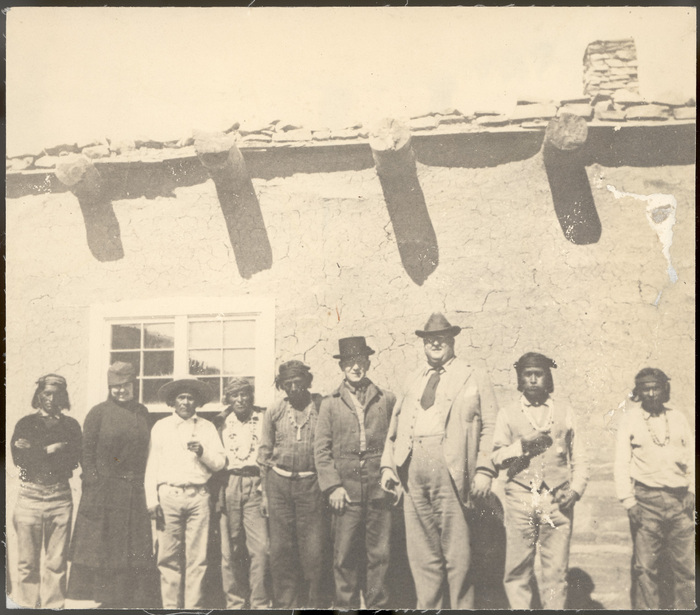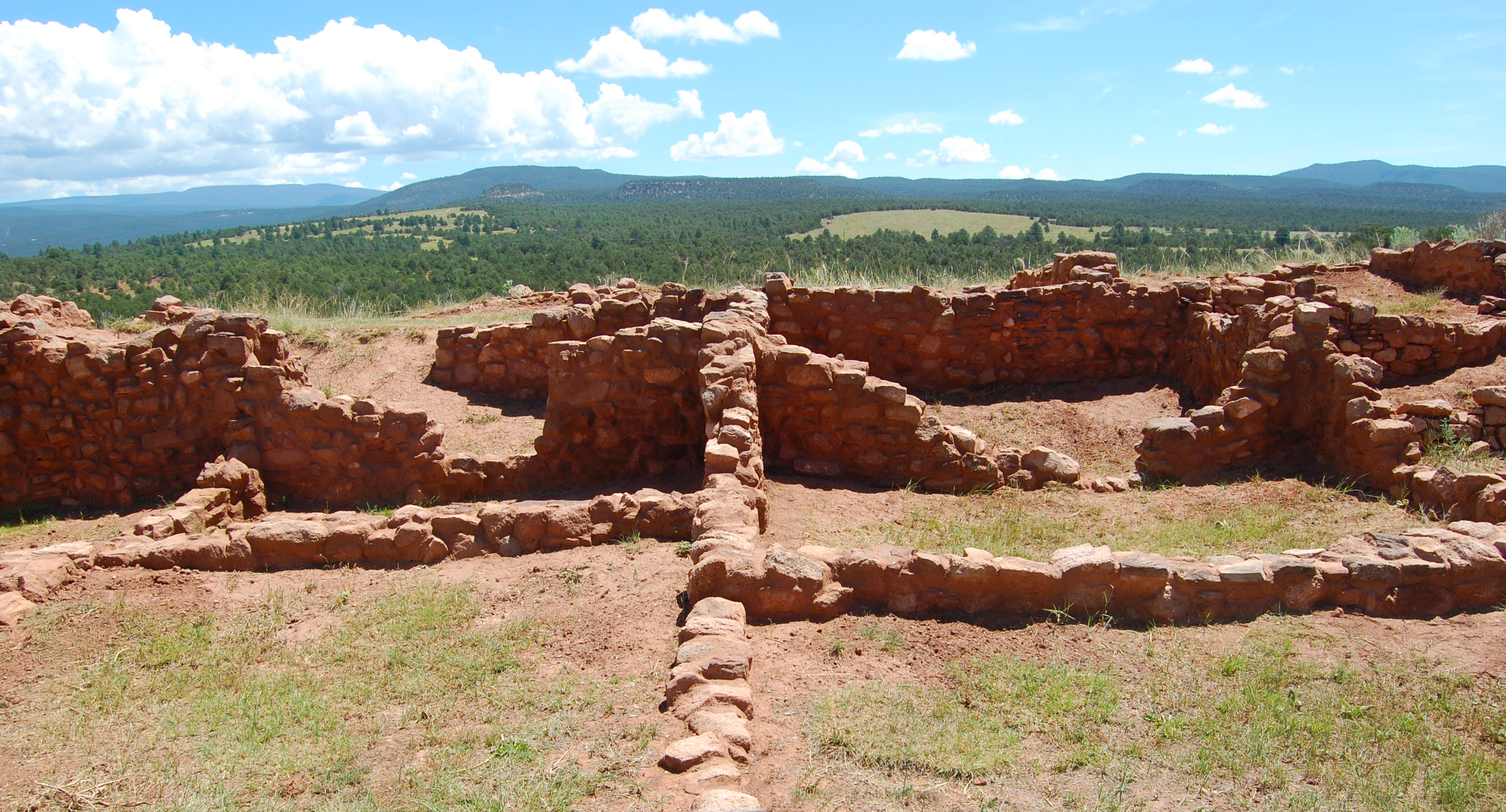|
Jesse Nusbaum
Jesse L. Nusbaum (1887–1975), was an American archaeologist, anthropologist, photographer and National Park Service Superintendent who lived in the American Southwest, where he made significant achievements in the identification, documentation, restoration and preservation of the region's Native American and Spanish Colonial architectural and cultural heritage. Personal life Jesse L. Nusbaum was born in Greeley, Colorado, on September 3, 1887, to Edward Moore and Agnes Strickland (Moodie) Nusbaum. His parents and maternal grandparents were members of the original Greeley colony organized by Horace Greeley. Nusbaum married Aileen Baehrens O'Bryan on September 21, 1920, whom he divorced in 1939. They had one son, Deric. Nusbaum subsequently married Rosemary Lewis Rife, a nurse, on December 11, 1947. He died in Santa Fe, New Mexico, on December 21, 1975, at the age of 88. A few years later, his wife, Rosemary, published two books on parts of Jesse's work (see Bibliography); she ... [...More Info...] [...Related Items...] OR: [Wikipedia] [Google] [Baidu] |
Archaeologist
Archaeology or archeology is the scientific study of human activity through the recovery and analysis of material culture. The archaeological record consists of artifacts, architecture, biofacts or ecofacts, sites, and cultural landscapes. Archaeology can be considered both a social science and a branch of the humanities. It is usually considered an independent academic discipline, but may also be classified as part of anthropology (in North America – the four-field approach), history or geography. Archaeologists study human prehistory and history, from the development of the first stone tools at Lomekwi in East Africa 3.3 million years ago up until recent decades. Archaeology is distinct from palaeontology, which is the study of fossil remains. Archaeology is particularly important for learning about prehistoric societies, for which, by definition, there are no written records. Prehistory includes over 99% of the human past, from the Paleolithic until the adve ... [...More Info...] [...Related Items...] OR: [Wikipedia] [Google] [Baidu] |
Bandelier National Monument
Bandelier National Monument is a United States National Monument near Los Alamos in Sandoval and Los Alamos counties, New Mexico. The monument preserves the homes and territory of the Ancestral Puebloans of a later era in the Southwest. Most of the pueblo structures date to two eras, dating between 1150 and 1600 AD. The monument is of the Pajarito Plateau, on the slopes of the Jemez volcanic field in the Jemez Mountains. Over 70% of the monument is wilderness, with over one mile of elevation change, from about along the Rio Grande to over at the peak of Cerro Grande on the rim of the Valles Caldera, providing for a wide range of life zones and wildlife habitats. of road and more than of hiking trails are built. The monument protects Ancestral Pueblo archeological sites, a diverse and scenic landscape, and the country's largest National Park Service Civilian Conservation Corps National Landmark District. Two-thirds of the park, , is designated as the Bandelier Wilderness ... [...More Info...] [...Related Items...] OR: [Wikipedia] [Google] [Baidu] |
World War I
World War I (28 July 1914 11 November 1918), often abbreviated as WWI, was one of the deadliest global conflicts in history. Belligerents included much of Europe, the Russian Empire, the United States, and the Ottoman Empire, with fighting occurring throughout Europe, the Middle East, Africa, the Pacific, and parts of Asia. An estimated 9 million soldiers were killed in combat, plus another 23 million wounded, while 5 million civilians died as a result of military action, hunger, and disease. Millions more died in genocides within the Ottoman Empire and in the 1918 influenza pandemic, which was exacerbated by the movement of combatants during the war. Prior to 1914, the European great powers were divided between the Triple Entente (comprising France, Russia, and Britain) and the Triple Alliance (containing Germany, Austria-Hungary, and Italy). Tensions in the Balkans came to a head on 28 June 1914, following the assassination of Archduke Franz Ferdin ... [...More Info...] [...Related Items...] OR: [Wikipedia] [Google] [Baidu] |
Zuni Pueblo, New Mexico
Zuni Pueblo (also Zuñi Pueblo, Zuni: ''Halona Idiwan’a'' meaning ‘Middle Place’) is a census-designated place (CDP) in McKinley County, New Mexico, United States. The population was 6,302 as of the 2010 Census. It is inhabited largely by members of the Zuni people (''A:shiwi''). The first contact with Spaniards occurred in 1539 in the ancient village of Hawikku when Esteban, an Arab/Berber of Moroccan origin, entered Zuni territory seeking the fabled "Seven Cities of Cibola" and when Marco da Nizza, an Italian franciscan, reached Zuni Pueblo and called it ''Cibola''. It is on the Trails of the Ancients Byway, one of the designated New Mexico Scenic Byways.Trail of the Ancients. New Mexico Tourism Department. Retrieved August 14, 2014. Geography Zuni Pueblo is located at (35.069327, -108.846716) ...[...More Info...] [...Related Items...] OR: [Wikipedia] [Google] [Baidu] |
Hawikuh
Hawikuh (also spelled ''Hawikku'', meaning "gum leaves" in ZuniLanmon, Dwight P. and Harlow, Francis, "A brief history of the Ashiwi (Zuni) pueblos", in ''The Pottery of Zuni Pueblo'', 2008, Museum of New Mexico Press. ), was one of the largest of the Zuni pueblos at the time of the Spanish ''entrada''. It was founded around 1400 AD. It was the first pueblo to be visited and conquered by Spanish explorers. The pueblo site is located southwest of Zuni Pueblo, on what is now the Zuni Indian Reservation in Cibola County, New Mexico. In 1960 the site was designated as a National Historic Landmark known as the Hawikuh Ruins. It is included as a contributing part of the Zuni-Cibola Complex of archaeological sites, a larger National Historic Landmark District designated by the United States Department of Interior in 1974. History In 1539, Estevanico was the first non-native to visit Hawikuh. Rumors and legends revolving around the disappearance of Estevanico in the region eventually ... [...More Info...] [...Related Items...] OR: [Wikipedia] [Google] [Baidu] |
Frederick Webb Hodge
Frederick Webb Hodge (October 28, 1864 – September 28, 1956) was an American editor, anthropologist, archaeologist, and historian. Born in England, he immigrated at the age of seven with his family to Washington, DC. He was educated at American schools, and graduated from Cambridge College (now George Washington University). He became very interested in Native American history and cultures, and worked for the Bureau of American Ethnology from 1905 to 1918. He collaborated with George Gustav Heye, who had been collecting Native American artifacts, and established the Heye Foundation to support archeological work. Heye founded the Museum of the American Indian in 1916 in New York, where Hodge later served as editor and assistant director. During his time at the Smithsonian, Hodge also conducted archeological expeditions and excavations at Nacoochee Mound in Georgia, and at Hawikuh, near Zuni Pueblo. Early years Frederick Webb Hodge was born in 1864 in Plymouth, England to Edwin ... [...More Info...] [...Related Items...] OR: [Wikipedia] [Google] [Baidu] |
Pecos Pueblo
Pecos National Historical Park is a United States National Historical Park in San Miguel and Santa Fe Counties, New Mexico. The park, operated by the National Park Service, encompasses thousands of acres of landscape infused with historical elements from prehistoric archaeological ruins to 19th-century ranches, to a battlefield of the American Civil War. Its largest single feature is Pecos Pueblo also known as Cicuye Pueblo, a Native American community abandoned in historic times. First a state monument in 1935, it was made Pecos National Monument in 1965, and greatly enlarged and renamed in 1990. Two sites within the park, the pueblo and the Glorieta Pass Battlefield, are National Historic Landmarks. Features Pecos National Historical Park's main unit is located in western San Miguel County, about east of Santa Fe and just south of Pecos. Pecos Pueblo The main unit of the park preserves the ruins of Pecos Pueblo, known historically as Cicuye (sometimes spelled Ciquiq ... [...More Info...] [...Related Items...] OR: [Wikipedia] [Google] [Baidu] |
Maya Civilization
The Maya civilization () of the Mesoamerican people is known by its ancient temples and glyphs. Its Maya script is the most sophisticated and highly developed writing system in the pre-Columbian Americas. It is also noted for its art, architecture, mathematics, calendar, and astronomical system. The Maya civilization developed in the Maya Region, an area that today comprises southeastern Mexico, all of Guatemala and Belize, and the western portions of Honduras and El Salvador. It includes the northern lowlands of the Yucatán Peninsula and the highlands of the Sierra Madre, the Mexican state of Chiapas, southern Guatemala, El Salvador, and the southern lowlands of the Pacific littoral plain. Today, their descendants, known collectively as the Maya, number well over 6 million individuals, speak more than twenty-eight surviving Mayan languages, and reside in nearly the same area as their ancestors. The Archaic period, before 2000 BC, saw the first developments in agricul ... [...More Info...] [...Related Items...] OR: [Wikipedia] [Google] [Baidu] |
Fred Harvey (entrepreneur)
Frederick Henry Harvey (June 27, 1835 – February 9, 1901) was an entrepreneur who developed the Harvey House lunch rooms, restaurants, souvenir shops, and hotels, which served rail passengers on the Atchison, Topeka and Santa Fe Railway, the Gulf Colorado and Santa Fe Railway, the Kansas Pacific Railway, the St. Louis-San Francisco Railway, and the Terminal Railroad Association of St. Louis. As an innovative restaurateur and marketer, Fred Harvey is credited with creating the first restaurant chain in the United States. He was also a leader in promoting tourism in the American Southwest in the late 19th century. Fred Harvey and his employees successfully brought new higher standards of both civility and dining to a region widely regarded in the era as "the Wild West." He created a legacy which was continued by his sons and remained in the family until the death of a grandson in 1965. Despite the decline of passenger train patronage in the United States in the 20th century wi ... [...More Info...] [...Related Items...] OR: [Wikipedia] [Google] [Baidu] |
San Diego
San Diego ( , ; ) is a city on the Pacific Ocean coast of Southern California located immediately adjacent to the Mexico–United States border. With a 2020 population of 1,386,932, it is the List of United States cities by population, eighth most populous city in the United States and the county seat, seat of San Diego County, the List of the most populous counties in the United States, fifth most populous county in the United States, with 3,338,330 estimated residents as of 2019. The city is known for its mild year-round climate, natural deep-water harbor, extensive beaches and parks, long association with the United States Navy, and recent emergence as a healthcare and biotechnology development center. San Diego is the List of municipalities in California, second largest city in the U.S. state, state of California, after Los Angeles. Historically home to the Kumeyaay people, San Diego is frequently referred to as the "Birthplace of California", as it was the first site vi ... [...More Info...] [...Related Items...] OR: [Wikipedia] [Google] [Baidu] |
.jpg)





.jpg)